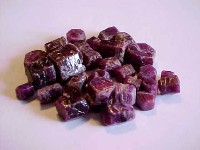

Ruby or carbuncle is a red variety of corundum, otherwise known as sapphire. All other color variations of this stone, including pink, are referred to as sapphire. Corundum comes from the Sanskrit kuruvinda however, meaning “ruby,” so what’s in a name? According to Hindu legend, the red corundum formed from the blood of a maharina (queen) and a colorless diamond as she was stabbed to death by a jealous courtier. It is a special stone to Hindus, assigned to the Brahmin caste. The ruby represents the beauty of the soul.
Myths surrounding the mining of rubies abound. In many places where they were mined, it was thought they needed time to “ripen” in color. Pale rubies were those which had been harvested too soon. Some believe a ruby will darken as danger approaches however. Some miners stole rubies by inserting them into cuts on the arm or leg, covered by a bandage. This created a Burmese belief that they conferred invulnerability on their owner if inserted into the flesh of the body.
One of the early myths about rubies were that they could store heat so that a ruby placed in cold water could bring it to a boil. According to another story, rubies created their own light, independent of any refraction. Pegu, ling of southern Burma was said to have built a city lit entirely by the power of rubies, and Epiphanius declared a ruby could not be stolen for its internal light would shine through whatever it was hidden in. Unless they have been exposed to ultraviolet however, rubies will not glow in the dark.
Ruby was considered in many cultures to be the greatest protective stone. Touched to the corners of a house, garden, or vineyard, the area was safeguarded from storms and worms. It is said to banish foolish thought to make the bearer prudent. Marital happiness was secure under the power of ruby. One source suggests ruby may be helpful in making contact with nature spirits. It is supposed to protect the wearer from nightmares but at the same time bring lucidity to dreams.
Due to the rich red color of the ruby, much healing lore has built up about them. The Ruby is said to be ruled over by Mars, not only a god of war, but also of physical vitality. It will protect warriors in battle or preserve the health of its owner. Rubbed on the face, a ruby could preserve youth. Rubies were said to ward off plague, toothache, poison and plots. According the thirteenth century Hebrew grimoire, the Book of Wings, a ruby carven with the image of a dragon guaranteed health, wealth, and happiness. They were to worn only on the left side of the body in association with the “female” side of the body and the heart’s blood. Worn as a brooch, ruby is said to help the circulatory and immune systems.
Types of Ruby
Star rubies (similar to star sapphires) are caused by rutile crystal within the stone. They are regarded as love stones in Europe where six is a traditional number of Venus. Primitive people believed stones with such markings housed spirits.

Anyolite is composed of ruby and hornblende crystals embedded in green zoisite. Though anyolite increases awareness of your own individuality, it does not do so at the cost of your connection to the rest of humanity. It is useful in augmenting all altered forms of consciousness and amplifying or activating psychical abilities. Healers in Asiatic countries have put anyolite to use in both diagnosing illness and communication with helpful spirits.